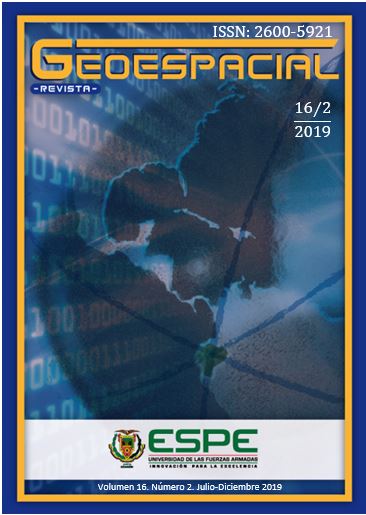EL CRECIMIENTO URBANO Y SU INFLUENCIA EN LOS CAUDALES DE CRECIDA: UN CASO DE ESTUDIO EN UNA CUENCA URBANA EN LOS ANDES ECUATORIANOS
Contenido principal del artículo
Resumen
El notable crecimiento urbano que han experimentado varias ciudades en el Ecuador en los últimos años ha provocado cambios en el uso de suelo de las cuencas hidrográficas de las que ellas forman parte. Desde el punto de vista hidrológico el cambio de uso del suelo se ve reflejado en el cambio de la respuesta de una cuenca hidrográfica a eventos extremos de precipitación. En el presente estudio se realiza un análisis multitemporal (1976- 2010) del crecimiento urbano de la ciudad de Loja, capital de la provincia ecuatoriana del mismo nombre, determinándose el crecimiento experimentado por la ciudad y la variación del uso de suelo en la cuenca del río Zamora durante el período considerando. Para la evaluación de los caudales de crecida, según las diferentes etapas de crecimiento urbano, se implementó un modelo hidrológico de evento. El análisis multitemporal del crecimiento urbano, la obtención de parámetros hidrológicos y la presentación de resultados se realizó aplicando Sistemas de Información Geográfica. Los resultados permiten demostrar la relación directa entre el crecimiento del área urbana y el incremento de la magnitud de los caudales de crecida.
Detalles del artículo
Acceso a archivos
Los artículos publicados en la Revista Geoespacial se sujetan a las directrices de OPEN ACCES, en cuanto a la apertura de su contenido hacia todos los visitantes del sitio.
Derechos que conserva el autor:
El autor conserva los derechos morales de publicación
Cesión de derechos a autores:
Se cede los derechos de citas, referencias y temas relacionados con aspectos académicos y de investigación
Cómo citar
Referencias
Chow V.T, R. Maidmentm, L. Mays. (1994) “Hidrología aplicada”. McGraw, Hill Bogotá.
Chuvieco. E. (2010) Teledetección ambiental, Ariel ediciones, Madrid
Cruise, J.F., Laymon, C.A., Al-Hamdan, O.Z. (2010) Impact of 20 years of land-cover change on the hydrology of streams in the Southeastern United States1. JAWRA J. Am. Water Resour. Assoc. 46, 1159–1170.
Dingman, L. (2015), Physical Hydrology: Third Edition, Waveland Press, Long Grove, Illinois
Eastman, J.R. (2006) IDRISI Andes. Tutorial. Clark-Labs, Clark University, Worcester, MA.
Fletcher, T.D., H. Andrieu, P. Hamel. (2013) Understanding, management and modelling of urban hydrology and its consequences for receiving waters: A state of the art. Advances in Water Resources 51: 261–279
Hegerl, G.C., von Storch, H., Hasselmann, K., Santer, B.D., Cubasch, U., Jones, P.D., (1996) Detecting greenhouse-gas-induced climate change with an optimal fingerprint method. J. Clim. 9, 2281-2306.
Huang, J.-C., Lin, C.-C., Chan, S.-C., Lee, T.-Y., Hsu, S.-C., Lee, C.-T., Lin, J.-C. (2012) Stream discharge characteristics through urbanization gradient in Danshui River, Taiwan: perspectives from observation and simulation. Environ. Monit. Assess. 184, 5689–5703.
INAMHI (2019) Determinación de ecuaciones para el cálculo de intensidades máximas de precipitación. Versión 2. Instituto Nacional de Hidrología y Meteorología, Quito, Ecuador, 282 p.
Kleinbaum, D. G., Klein, M. (2002) Logistic Regression. A Self-Learning Text, Second Edition, Springer, N.Y. 513 p.
Oñate-Valdivieso, F., Sendra, J. (2010) Application of GIS and remote sensing techniques in generation of land use scenarios for hydrological modeling. Journal of Hydrology 395(3), 256 - 263
Oñate-Valdivieso, F., Sendra, J. (2014) Semidistributed Hydrological Model with Scarce Information: Application to a Large South American Binational Basin, J. Hydrol. Eng., 19(5), 1006–1014.
Pijanowski, B. C., Brown D. G., Shellito B. A., Manik G. A. (2002) Using neural networks and GIS to forecast land use changes: a Land Transformation Model. Computers, Environment and Urban Systems. 26, 553–575.
Pontius, R., Shusas, E., McEachern (2004) Detecting important categorical land changes while accounting for persistence, Agriculture Ecosystems & Environment, 101(2):251-268
Santer, B.D., Mears, C., Doutriaux, C., Caldwell, P., Gleckler, P.J., Wigley, T.M.L., Solomon, S., Gillett, N.P., Ivanova, D., Karl, T.R., Lanzante, J.R., Meehl, G.A., Stott, P.A., Taylor, K.E., Thorne, P.W., Wehner, M.F., Wentz, F.J. (2011) Separating signal and noise in atmospheric temperature changes: the importance of timescale. J. Geophys. Res. Atmos. 116, n/a–n/a.
United Nations. (2010) World urbanization prospects: the 2009 revision. New York: United Nations Department of Economic and Social Affairs (Population Division)
Zhang, X., Zwiers, F.W., Hegerl, G.C., Lambert, F.H., Gillett, N.P., Solomon, S., Stott, P.A., Nozawa, T. (2007). Detection of human influence on twentieth-century precipitation trends. Nature 448, 461–465.
Zheng, J., Yu, X., Deng, W., Wang, H., Wang, Y. (2012). Sensitivity of land–use change to streamflow in Chaobai River Basin. J. Hydrol. Eng. 18, 457–464.

